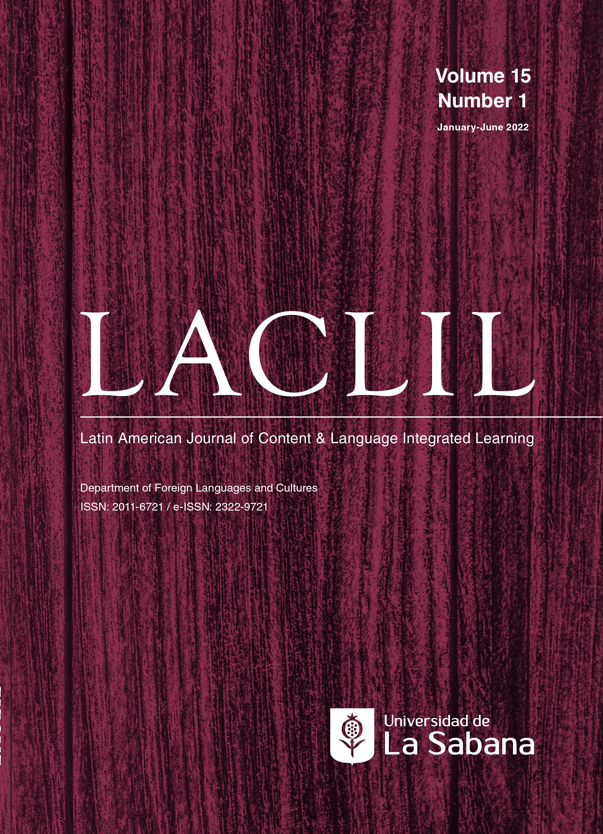A CLIL Curriculum Design for Future Professionals of Hospitality and Tourism Management
DOI:
https://doi.org/10.5294/laclil.2022.15.1.3Keywords:
CLIL, curriculum development, educational courses, communicative skills, tourism and hospitalityAbstract
This paper outlines a description of research carried out at a public university in Colombia where students of the Hospitality and Tourism Management program took four general English levels in 2017 as a requirement to graduate. According to the data collected, these levels were not enough to acquire the necessary knowledge and skills to interact in English. This need, determined through questionnaires, and a CNA report were the starting point of this research study, whose main objective was to enrich students’ language learning skills and knowledge through a CLIL curriculum. This participatory action research is framed within a qualitative study. After designing, implementing, and piloting one unit, including four lessons, we determined that not only students’ language learning skills can be improved but also their confidence, participation, solidarity, and awareness of their and others’ learning process through the activities designed and strategies proposed by this approach.
Downloads
References
Anderson, L., & Krathwohl, D. (2001). Taxonomy for Learning, Teaching, and Assessing, A: a revision of Bloom’s Taxonomy of educational objectives. Abridged Edition.
Bentley, K. (2010). The TKT Course CLIL Module: Content and Language Integrated Learning. Cambridge University Press.
Coyle, D., Hood, P., & Marsh, D. (2010). CLIL Content and Language Integrated Learning. Cambridge University Press. https://doi.org/10.1017/9781009024549
Creswell, J. (2012). Educational Research: Planning, conducting, and evaluating quantitative and qualitative research (4th ed.). Pearson.
Christison, M., & Murray, D. (2014). What English Language Teachers Need to Know Volume III: Designing Curriculum (1st ed.). ESL & Applied Linguistics Professional Series.
Dale, L., & Tanner, R. (2012). CLIL activities with CD-ROM: a resource for subject and language teachers. Cambridge University Press.
Gobernación de Boyacá. (2012). Plan Departamental de Desarrollo. Boyacá se atreve! 2012-2015. http://boyaca.gov.co/SecInfraestructura/images/CDGRD/Documentos%20de%20Inter%C3%A9s/Plan%20Departamental%20de%20Desarrollo%202012%20-%202015%20Boyac%C3%A1%20Se%20Atreve.pdf
Graves, K. (2000). Designing Language Courses: A Guide for Teachers. Newbury House Teacher Development.
Mehisto, P., Frigols, M., & Marsh, D. (2008). Uncovering CLIL: Content and Language Integrated Learning in Bilingual and Multilingual Education. Macmillan Education.
Mills, G. (2011). Action research: A guide for the teacher researcher (4th ed.). Pearson.
Ministerio de Educación Nacional. (2004). Programa Nacional de Bilingüismo. Colombia 2004-2019. Inglés como Lengua Extranjera: una estrategia para la competitividad. http://www.mineducacion.gov.co/1621/articles-132560_recurso_pdf_programa_nacional_bilinguismo.pdf
Ministerio de Educación Nacional. (2015). Programa Nacional de Inglés 2015-2025. Colombia Very Well. Programa de Socialización. https://www.mineducacion.gov.co/1759/articles-343837_Programa_Nacional_Ingles.pdf
Nation, I. S. P., & Macalister J. (2010). Language Curriculum Design. Routledge. https://doi.org/10.4324/9780203870730
Nunan, D. (1988). Syllabus Design. Oxford University Press.
Universidad Pedagógica y Tecnológica de Colombia. (2007). Plan Maestro Institucional 2007-2019. http://www.uptc.edu.co/export/sites/default/universidad/documentos/plan_maestro/plan_maestro.pdf
Universidad Pedagógica y Tecnológica de Colombia. (2015). Plan de Desarrollo Institucional 2015-2018. http://www.uptc.edu.co/export/sites/default/universidad/acerca_de/inf_comunidad/doc/2015/plan_desarrollo_2015_2018.pdf
Downloads
Published
How to Cite
Issue
Section
License
Copyright (c) 2022 Latin American Journal of Content & Language Integrated Learning

This work is licensed under a Creative Commons Attribution-NonCommercial-NoDerivatives 4.0 International License.
This Journal and its articles are published under the Creative Commons CC BY 4.0 DEED Attribution 4.0 International license. You are free to: Share — copy and redistribute the material in any medium or format for any purpose, even commercially. Adapt — remix, transform, and build upon the material for any purpose, even commercially. The license cannot revoke these freedoms as long as you follow the terms of the license.








